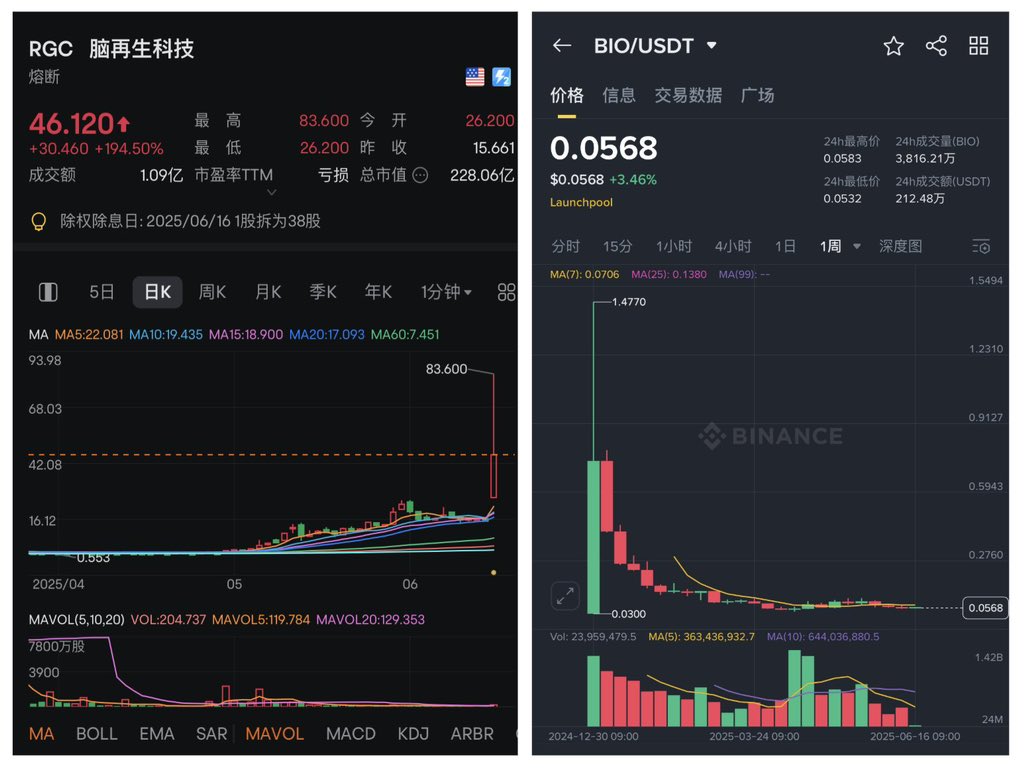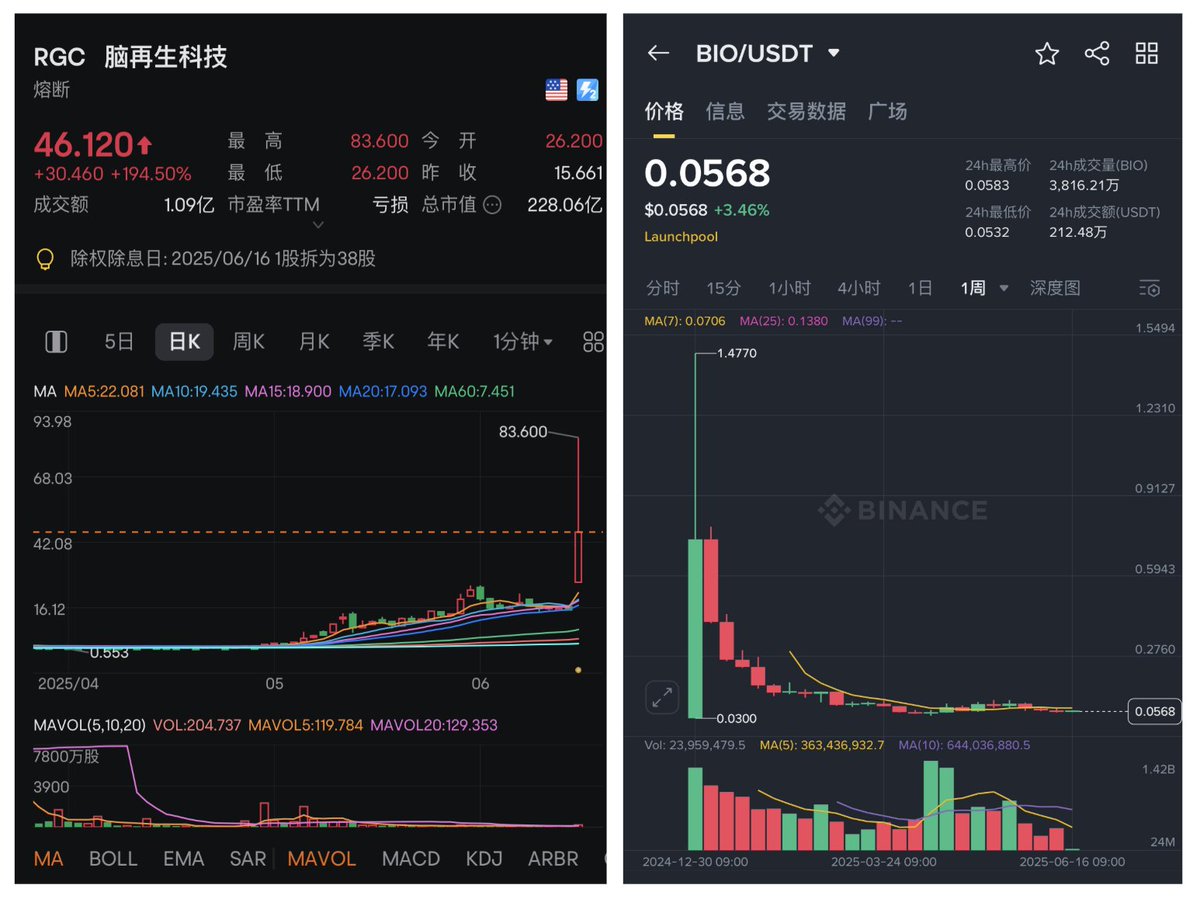
BIO
Preço de BIO
$0,045100
-$0,00051
(-1,12%)
Alteração de preço nas últimas 24 horas

Aviso legal
Os conteúdos sociais nesta página ("Conteúdos"), que incluem, entre outros, os tweets e estatísticas fornecidos pela LunarCrush, provêm de terceiros e destinam-se a fins informativos conforme estão disponibilizados. A OKX não garante a qualidade ou a exatidão dos Conteúdos, sendo que os mesmos não representam as opiniões da OKX. Não visam fornecer (i) aconselhamento ou recomendações de investimento; (ii) uma oferta ou solicitação para comprar, vender ou deter ativos digitais; ou (iii) aconselhamento financeiro, contabilístico, jurídico ou fiscal. Os ativos digitais, incluindo criptomoedas estáveis e NFTs, envolvem um elevado grau de risco e podem sofrer grandes flutuações. O preço e o desempenho dos ativos digitais não são garantidos e podem mudar sem aviso.
A OKX não fornece recomendações de investimentos ou de ativos. Deve ponderar cuidadosamente se fazer trading ou deter ativos digitais é o mais adequado para si, tendo em conta a sua situação financeira. Informe-se junto do seu consultor jurídico/fiscal/de investimentos para esclarecer questões relativas às suas circunstâncias específicas. Para obter mais detalhes, consulte os nossos Termos de Utilização e o Aviso de Risco. Ao utilizar o site de terceiros ("TPW"), aceita que qualquer utilização do TPW está sujeita e será regida pelos termos do TPW. Salvo indicação expressa por escrito, a OKX e os seus afiliados ("OKX") não estão, de forma alguma, associados ao proprietário ou operador do TPW. Concorda que a OKX não é responsável nem imputável por quaisquer perdas, danos e outras consequências que advenham da sua utilização do TPW. Tenha presente que utilizar um TPW poderá resultar na perda ou diminuição dos seus ativos. O produto poderá não estar disponível em todas as jurisdições.
A OKX não fornece recomendações de investimentos ou de ativos. Deve ponderar cuidadosamente se fazer trading ou deter ativos digitais é o mais adequado para si, tendo em conta a sua situação financeira. Informe-se junto do seu consultor jurídico/fiscal/de investimentos para esclarecer questões relativas às suas circunstâncias específicas. Para obter mais detalhes, consulte os nossos Termos de Utilização e o Aviso de Risco. Ao utilizar o site de terceiros ("TPW"), aceita que qualquer utilização do TPW está sujeita e será regida pelos termos do TPW. Salvo indicação expressa por escrito, a OKX e os seus afiliados ("OKX") não estão, de forma alguma, associados ao proprietário ou operador do TPW. Concorda que a OKX não é responsável nem imputável por quaisquer perdas, danos e outras consequências que advenham da sua utilização do TPW. Tenha presente que utilizar um TPW poderá resultar na perda ou diminuição dos seus ativos. O produto poderá não estar disponível em todas as jurisdições.
Informações do mercado de BIO
Capitalização do mercado
A capitalização do mercado é calculada ao multiplicar a oferta em circulação de uma moeda pelo último preço da mesma.
Capitalização do mercado = Oferta em circulação × Último preço
Capitalização do mercado = Oferta em circulação × Último preço
Oferta em circulação
O montante total de uma moeda que está disponível no mercado.
Classificação da capitalização de mercado
A classificação de uma moeda no que diz respeito ao valor da capitalização do mercado.
Máximo histórico
O preço mais elevado que uma moeda atingiu no seu histórico de trading.
Mínimo histórico
O preço mais baixo que uma moeda atingiu no seu histórico de trading.
Capitalização do mercado
$80,47M
Oferta em circulação
1 791 385 932 BIO
53,95% de
3 320 000 000 BIO
Classificação da capitalização de mercado
--
Auditorias
CertiK
Última auditoria: --
Máximo em 24h
$0,046160
Mínimo em 24h
$0,041710
Máximo histórico
$0,90750
-95,04% (-$0,86240)
Última atualização: 3/01/2025, (UTC+8)
Mínimo histórico
$0,040470
+11,44% (+$0,0046300)
Última atualização: 17/04/2025, (UTC+8)
Como se sente hoje relativamente à BIO?
Partilhe as suas opiniões aqui ao dar um <i>thumbs up</i> caso se sinta <i>bullish</i> em relação à moeda ou <i>thumbs down</i> caso se sinta <i>bearish</i>.
Vote para ver os resultados
Feed de BIO
O seguinte conteúdo é proveniente do .

쓰니 | SSUNI (APT/KAIA/ACC) 🇰🇷
Não posso simplesmente ignorar o tweet sobre @BasisOS $BIO, que tem sido cheio de conversas e controvérsias. Como todos sabem, a Temporada 1 de mineração MyShare de @BasisOS terminou em 29 de julho. Olhando para trás desde o final de abril, não posso deixar de sentir um pouco de arrependimento, pensando que deveria ter começado um pouco mais cedo. Tenho sentido isso há um tempo, mas, honestamente, não há nada sobre o que escrever. Parece que não houve novas atualizações, e é difícil criar um tweet sobre farming. @virtuals_io
Mostrar original9,01 mil
1

Dr.UZ
Há seis meses, se você tivesse comprado
não o #DeSci (ciência descentralizada) $BIO do mundo das criptomoedas,
más sim o #TraSci (ciência centralizada) $RGC das ações americanas,
você teria obtido um retorno de 350 vezes.
Que droga
Tecnologia avançada ainda é melhor comprar ações de empresas listadas, no mundo das criptomoedas, você pode comprar apenas o que está relacionado à inovação financeira😅😅
Mas $pythia 🧠🐁 é uma exceção😎, $pythia tem uma empresa listada por trás.


AB Kuai.Dong
Há seis meses, se você tivesse investido em DeSci (ciência descentralizada) do mundo das criptomoedas, em vez de em tecnologia regenerativa das ações americanas (ciência centralizada), você teria obtido um retorno de 350 vezes.

25,3 mil
36

쓰니 | SSUNI (APT/KAIA/ACC) 🇰🇷
Analisando esta questão de quantidade com @BasisOS, tenho algumas reflexões. Desde que publiquei a imagem da mineração no Twitter para a agricultura social, não é fácil verificar a quantidade e ter evidências claras para comparação.
Mas também penso muito porque ajustes de quantidade eram possíveis. $BIO
Mostrar original11,35 mil
3

쓰니 | SSUNI (APT/KAIA/ACC) 🇰🇷
Ah, preciso escrever sobre @BasisOS. Pessoalmente, achei interessante quando o encontrei pela primeira vez.
Há muitas discussões, mas me pergunto se seria mais divertido se projetos semelhantes continuassem a ser lançados no mercado ou se surgissem projetos que pudessem criar sinergia. Não acho que seja um projeto que vai desaparecer da noite para o dia, certo? Ou talvez não. Quem sabe! $BIO @virtuals_io
Mostrar original12,3 mil
4
Converter USD em BIO


Desempenho do preço de BIO em USD
O preço atual de BIO é $0,045100. Ao longo das últimas 24 horas, o BIO teve diminuiu por -1,12%. Atualmente, tem uma oferta em circulação de 1 791 385 932 BIO e uma oferta máxima de 3 320 000 000 BIO, o que resulta numa capitalização de mercado totalmente diluída de $80,47M. De momento, a BIO ocupa a 0 posição nas classificações de cap. do mercado. O preço de BIO/USD é atualizado em tempo real.
Hoje
-$0,00051
-1,12%
7 dias
-$0,01089
-19,45%
30 dias
-$0,04150
-47,93%
3 meses
-$0,05569
-55,26%
Conversões de BIO populares
Última atualização: 23/06/2025, 12:26
| 1 BIO em USD | 0,044920 $ |
| 1 BIO em EUR | 0,039081 € |
| 1 BIO em PHP | 2,5880 ₱ |
| 1 BIO em IDR | 740,77 Rp |
| 1 BIO em GBP | 0,033479 £ |
| 1 BIO em CAD | 0,061834 $ |
| 1 BIO em AED | 0,16497 AED |
| 1 BIO em VND | 1175,61 ₫ |
Sobre BIO (BIO)
A classificação fornecida é uma classificação agregada recolhida pela OKX a partir das fontes fornecidas e destina-se apenas a fins informativos. A OKX não garante a qualidade ou a exatidão das classificações. Não visa fornecer (i) aconselhamento ou recomendações de investimento; (ii) uma oferta ou solicitação para comprar, vender ou deter ativos digitais; ou (iii) aconselhamento financeiro, contabilístico, jurídico ou fiscal. Os ativos digitais, incluindo criptomoedas estáveis e NFTs, envolvem um elevado grau de risco, podem ter grandes flutuações e podem, inclusivamente, perder todo o valor. O preço e o desempenho dos ativos digitais não são garantidos e podem mudar sem aviso. Os seus ativos digitais não estão cobertos por seguro contra eventuais perdas. Os ganhos históricos não são indicativos de ganhos futuros. A OKX não garante quaisquer ganhos nem a amortização do capital ou dos juros. A OKX não fornece recomendações de investimento ou de ativos. Deve ponderar cuidadosamente se transacionar ou deter ativos digitais vai ao encontro da sua condição financeira. Informe-se junto do seu consultor jurídico/fiscal/de investimentos para esclarecer questões relativas às suas circunstâncias específicas.
Mostrar mais
- Site oficial
- Documento técnico
- Explorador de blocos
Acerca dos sites de terceiros
Acerca dos sites de terceiros
Ao utilizar o site de terceiros ("TPW"), aceita que qualquer utilização do TPW está sujeita e será regida pelos termos do TPW. Salvo indicação expressa por escrito, a OKX e os seus afiliados ("OKX") não estão, de forma alguma, associados ao proprietário ou operador do TPW. Concorda que a OKX não é responsável nem imputável por quaisquer perdas, danos e outras consequências que advenham da sua utilização do TPW. Tenha presente que utilizar um TPW poderá resultar na perda ou diminuição dos seus ativos.
Perguntas frequentes sobre BIO
Quanto vale 1 BIO hoje?
Atualmente, um BIO vale $0,045100. Para obter respostas e informações sobre a ação do preço de BIO, está no sítio certo. Explore os gráficos BIO mais recentes e transacione de forma responsável com a OKX.
O que são as criptomoedas?
As criptomoedas, como BIO, são ativos digitais que operam num livro-razão público chamado blockchain. Saiba mais sobre as moedas e os tokens disponibilizados na OKX e os respetivos atributos diferentes, que inclui preços em direto e gráficos em tempo real.
Quando foram inventadas as criptomoedas?
Graças à crise financeira de 2008, o interesse em finanças descentralizadas aumentou. A Bitcoin proporcionou uma nova solução ao ser um ativo digital seguro numa rede descentralizada. Desde então, têm sido criados muitos outros tokens, como BIO.
O preço da BIO vai subir hoje?
Veja a nossa Página de previsão do preço de BIO para prever preços futuros e determinar os seus preços-alvo.
Divulgação ASG
Os regulamentos ASG (ambientais, sociais e de governação) para criptoativos visam abordar o seu impacto ambiental (por exemplo, mineração intensiva em termos de energia), promover a transparência e garantir práticas de governação éticas para alinhar a indústria das criptomoedas com objetivos sociais e de sustentabilidade mais amplos. Estes regulamentos incentivam a conformidade com normas que mitigam riscos e promovem a confiança nos ativos digitais.
Detalhes do ativo
Nome
OKcoin Europe LTD
Identificador de entidade jurídica relevante
54930069NLWEIGLHXU42
Nome do criptoativo
BIO
Mecanismo de consenso
BIO is present on the following networks: Base, Ethereum, Solana.
Base is a Layer-2 (L2) solution on Ethereum that was introduced by Coinbase and developed using Optimism's OP Stack. L2 transactions do not have their own consensus mechanism and are only validated by the execution clients. The so-called sequencer regularly bundles stacks of L2 transactions and publishes them on the L1 network, i.e. Ethereum. Ethereum's consensus mechanism (Proof-of-stake) thus indirectly secures all L2 transactions as soon as they are written to L1.
The crypto-asset's Proof-of-Stake (PoS) consensus mechanism, introduced with The Merge in 2022, replaces mining with validator staking. Validators must stake at least 32 ETH every block a validator is randomly chosen to propose the next block. Once proposed the other validators verify the blocks integrity. The network operates on a slot and epoch system, where a new block is proposed every 12 seconds, and finalization occurs after two epochs (~12.8 minutes) using Casper-FFG. The Beacon Chain coordinates validators, while the fork-choice rule (LMD-GHOST) ensures the chain follows the heaviest accumulated validator votes. Validators earn rewards for proposing and verifying blocks, but face slashing for malicious behavior or inactivity. PoS aims to improve energy efficiency, security, and scalability, with future upgrades like Proto-Danksharding enhancing transaction efficiency.
Solana uses a unique combination of Proof of History (PoH) and Proof of Stake (PoS) to achieve high throughput, low latency, and robust security. Here’s a detailed explanation of how these mechanisms work: Core Concepts 1. Proof of History (PoH): Time-Stamped Transactions: PoH is a cryptographic technique that timestamps transactions, creating a historical record that proves that an event has occurred at a specific moment in time. Verifiable Delay Function: PoH uses a Verifiable Delay Function (VDF) to generate a unique hash that includes the transaction and the time it was processed. This sequence of hashes provides a verifiable order of events, enabling the network to efficiently agree on the sequence of transactions. 2. Proof of Stake (PoS): Validator Selection: Validators are chosen to produce new blocks based on the number of SOL tokens they have staked. The more tokens staked, the higher the chance of being selected to validate transactions and produce new blocks. Delegation: Token holders can delegate their SOL tokens to validators, earning rewards proportional to their stake while enhancing the network's security. Consensus Process 1. Transaction Validation: Transactions are broadcast to the network and collected by validators. Each transaction is validated to ensure it meets the network’s criteria, such as having correct signatures and sufficient funds. 2. PoH Sequence Generation: A validator generates a sequence of hashes using PoH, each containing a timestamp and the previous hash. This process creates a historical record of transactions, establishing a cryptographic clock for the network. 3. Block Production: The network uses PoS to select a leader validator based on their stake. The leader is responsible for bundling the validated transactions into a block. The leader validator uses the PoH sequence to order transactions within the block, ensuring that all transactions are processed in the correct order. 4. Consensus and Finalization: Other validators verify the block produced by the leader validator. They check the correctness of the PoH sequence and validate the transactions within the block. Once the block is verified, it is added to the blockchain. Validators sign off on the block, and it is considered finalized. Security and Economic Incentives 1. Incentives for Validators: Block Rewards: Validators earn rewards for producing and validating blocks. These rewards are distributed in SOL tokens and are proportional to the validator’s stake and performance. Transaction Fees: Validators also earn transaction fees from the transactions included in the blocks they produce. These fees provide an additional incentive for validators to process transactions efficiently. 2. Security: Staking: Validators must stake SOL tokens to participate in the consensus process. This staking acts as collateral, incentivizing validators to act honestly. If a validator behaves maliciously or fails to perform, they risk losing their staked tokens. Delegated Staking: Token holders can delegate their SOL tokens to validators, enhancing network security and decentralization. Delegators share in the rewards and are incentivized to choose reliable validators. 3. Economic Penalties: Slashing: Validators can be penalized for malicious behavior, such as double-signing or producing invalid blocks. This penalty, known as slashing, results in the loss of a portion of the staked tokens, discouraging dishonest actions.
Mecanismos de incentivo e taxas aplicáveis
BIO is present on the following networks: Base, Ethereum, Solana.
Base is a Layer-2 (L2) solution on Ethereum that uses optimistic rollups provided by the OP Stack on which it was developed. Transaction on base are bundled by a, so called, sequencer and the result is regularly submitted as an Layer-1 (L1) transactions. This way many L2 transactions get combined into a single L1 transaction. This lowers the average transaction cost per transaction, because many L2 transactions together fund the transaction cost for the single L1 transaction. This creates incentives to use base rather than the L1, i.e. Ethereum, itself. To get crypto-assets in and out of base, a special smart contract on Ethereum is used. Since there is no consensus mechanism on L2 an additional mechanism ensures that only existing funds can be withdrawn from L2. When a user wants to withdraw funds, that user needs to submit a withdrawal request on L1. If this request remains unchallenged for a period of time the funds can be withdrawn. During this time period any other user can submit a fault proof, which will start a dispute resolution process. This process is designed with economic incentives for correct behaviour.
The crypto-asset's PoS system secures transactions through validator incentives and economic penalties. Validators stake at least 32 ETH and earn rewards for proposing blocks, attesting to valid ones, and participating in sync committees. Rewards are paid in newly issued ETH and transaction fees. Under EIP-1559, transaction fees consist of a base fee, which is burned to reduce supply, and an optional priority fee (tip) paid to validators. Validators face slashing if they act maliciously and incur penalties for inactivity. This system aims to increase security by aligning incentives while making the crypto-asset's fee structure more predictable and deflationary during high network activity.
Solana uses a combination of Proof of History (PoH) and Proof of Stake (PoS) to secure its network and validate transactions. Here’s a detailed explanation of the incentive mechanisms and applicable fees: Incentive Mechanisms 4. Validators: Staking Rewards: Validators are chosen based on the number of SOL tokens they have staked. They earn rewards for producing and validating blocks, which are distributed in SOL. The more tokens staked, the higher the chances of being selected to validate transactions and produce new blocks. Transaction Fees: Validators earn a portion of the transaction fees paid by users for the transactions they include in the blocks. This provides an additional financial incentive for validators to process transactions efficiently and maintain the network's integrity. 5. Delegators: Delegated Staking: Token holders who do not wish to run a validator node can delegate their SOL tokens to a validator. In return, delegators share in the rewards earned by the validators. This encourages widespread participation in securing the network and ensures decentralization. 6. Economic Security: Slashing: Validators can be penalized for malicious behavior, such as producing invalid blocks or being frequently offline. This penalty, known as slashing, involves the loss of a portion of their staked tokens. Slashing deters dishonest actions and ensures that validators act in the best interest of the network. Opportunity Cost: By staking SOL tokens, validators and delegators lock up their tokens, which could otherwise be used or sold. This opportunity cost incentivizes participants to act honestly to earn rewards and avoid penalties. Fees Applicable on the Solana Blockchain 7. Transaction Fees: Low and Predictable Fees: Solana is designed to handle a high throughput of transactions, which helps keep fees low and predictable. The average transaction fee on Solana is significantly lower compared to other blockchains like Ethereum. Fee Structure: Fees are paid in SOL and are used to compensate validators for the resources they expend to process transactions. This includes computational power and network bandwidth. 8. Rent Fees: State Storage: Solana charges rent fees for storing data on the blockchain. These fees are designed to discourage inefficient use of state storage and encourage developers to clean up unused state. Rent fees help maintain the efficiency and performance of the network. 9. Smart Contract Fees: Execution Costs: Similar to transaction fees, fees for deploying and interacting with smart contracts on Solana are based on the computational resources required. This ensures that users are charged proportionally for the resources they consume.
Início do período ao qual a divulgação é relativa
2024-06-14
Fim do período ao qual a divulgação é relativa
2025-06-14
Relatório de energia
Consumo de energia
285.86520 (kWh/a)
Consumo de energia renovável
26.542366745 (%)
Intensidade da energia
0.00004 (kWh)
Principais fontes de energia e metodologias
To determine the proportion of renewable energy usage, the locations of the nodes are to be determined using public information sites, open-source crawlers and crawlers developed in-house. If no information is available on the geographic distribution of the nodes, reference networks are used which are comparable in terms of their incentivization structure and consensus mechanism. This geo-information is merged with public information from Our World in Data, see citation. The intensity is calculated as the marginal energy cost wrt. one more transaction.
Ember (2025); Energy Institute - Statistical Review of World Energy (2024) – with major processing by Our World in Data. “Share of electricity generated by renewables – Ember and Energy Institute” [dataset]. Ember, “Yearly Electricity Data Europe”; Ember, “Yearly Electricity Data”; Energy Institute, “Statistical Review of World Energy” [original data]. Retrieved from https://ourworldindata.org/grapher/share-electricity-renewables
Fontes de consumo de energia e metodologias
The energy consumption of this asset is aggregated across multiple components:
To determine the energy consumption of a token, the energy consumption of the network(s) base, ethereum, solana is calculated first. For the energy consumption of the token, a fraction of the energy consumption of the network is attributed to the token, which is determined based on the activity of the crypto-asset within the network. When calculating the energy consumption, the Functionally Fungible Group Digital Token Identifier (FFG DTI) is used - if available - to determine all implementations of the asset in scope. The mappings are updated regularly, based on data of the Digital Token Identifier Foundation.
Relatório de emissões
Emissões de GEE de âmbito 1 da DLT — Controladas
0.00000 (tCO2e/a)
Emissões de GEE de âmbito 2 da DLT — Compradas
0.09515 (tCO2e/a)
Intensidade de GEE
0.00001 (kgCO2e)
Principais fontes de GEE e metodologias
To determine the GHG Emissions, the locations of the nodes are to be determined using public information sites, open-source crawlers and crawlers developed in-house. If no information is available on the geographic distribution of the nodes, reference networks are used which are comparable in terms of their incentivization structure and consensus mechanism. This geo-information is merged with public information from Our World in Data, see citation. The intensity is calculated as the marginal emission wrt. one more transaction.
Ember (2025); Energy Institute - Statistical Review of World Energy (2024) – with major processing by Our World in Data. “Carbon intensity of electricity generation – Ember and Energy Institute” [dataset]. Ember, “Yearly Electricity Data Europe”; Ember, “Yearly Electricity Data”; Energy Institute, “Statistical Review of World Energy” [original data]. Retrieved from https://ourworldindata.org/grapher/carbon-intensity-electricity Licenced under CC BY 4.0
Converter USD em BIO













